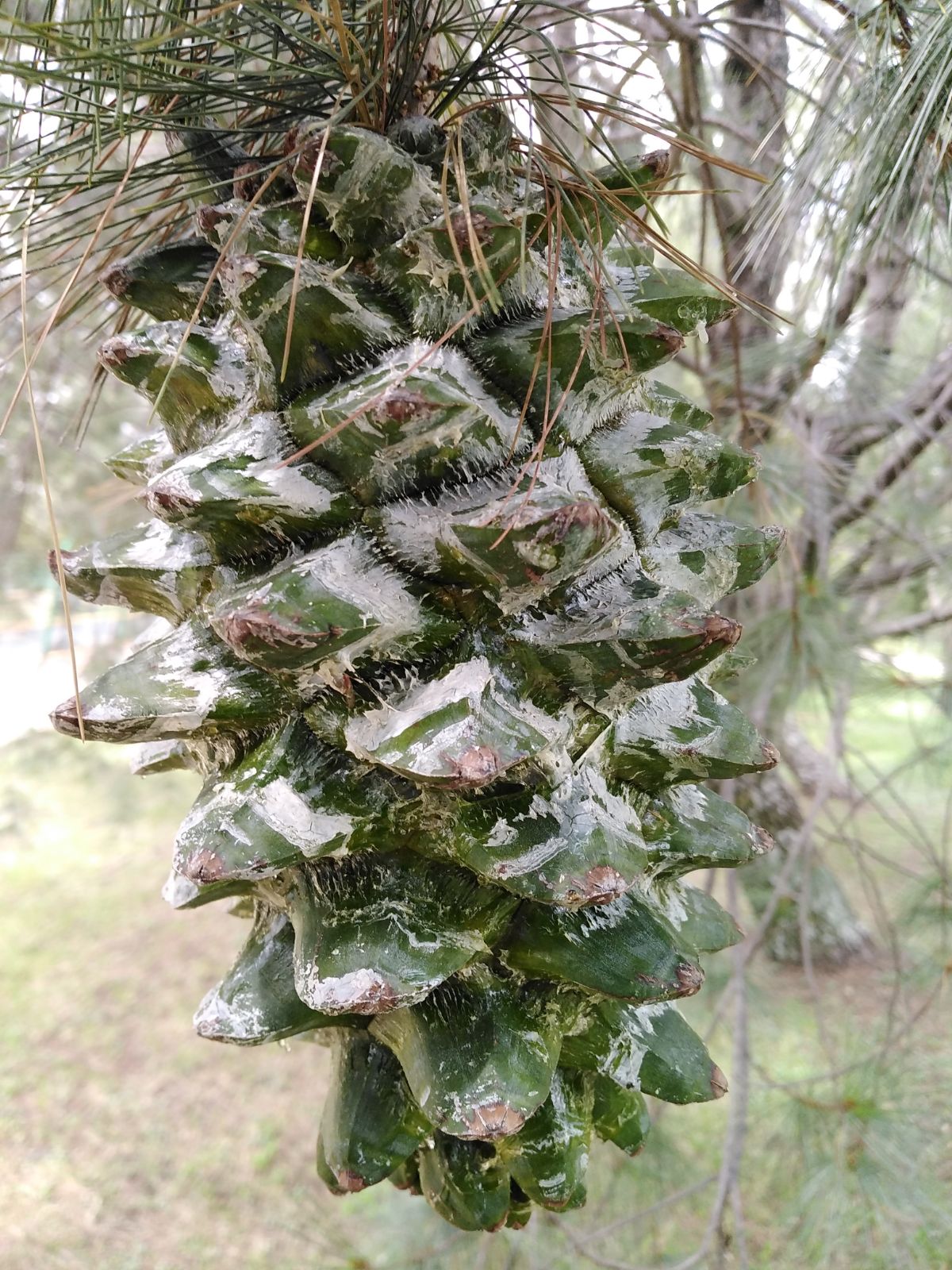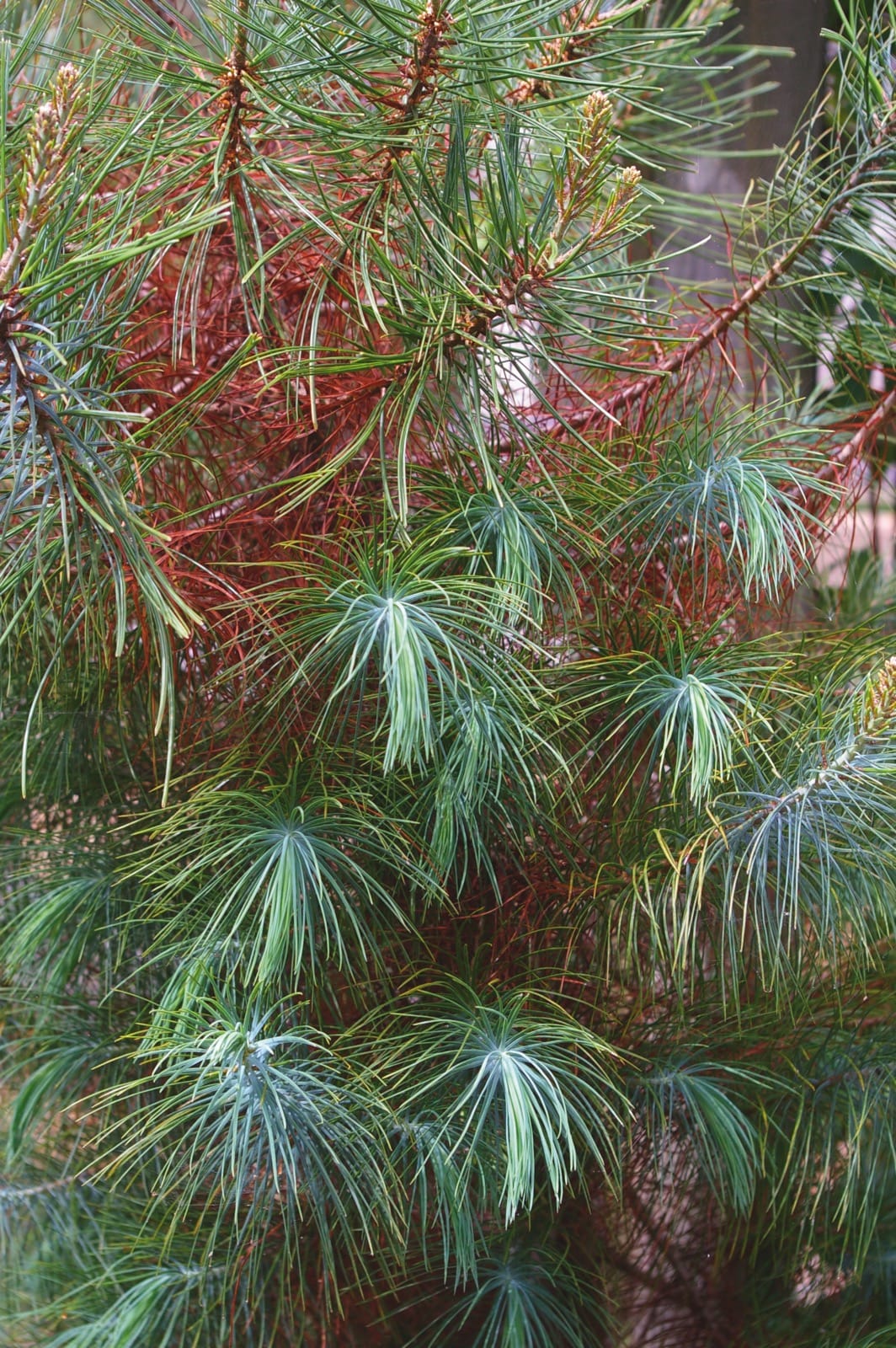Pinus maximartinezii
Credits
Article from New Trees by John Grimshaw & Ross Bayton
Recommended citation
'Pinus maximartinezii' from the website Trees and Shrubs Online (treesandshrubsonline.
Genus
- Pinus
- Subgen. Strobus, Sect. Parrya
Common Names
- Martínez's Pinyon
- Big-cone Pinyon
Other taxa in genus
- Pinus albicaulis
- Pinus arizonica
- Pinus armandii
- Pinus attenuata
- Pinus ayacahuite
- Pinus balfouriana
- Pinus banksiana
- Pinus bhutanica
- Pinus brutia
- Pinus bungeana
- Pinus canariensis
- Pinus cembra
- Pinus cembroides
- Pinus chiapensis
- Pinus contorta
- Pinus coulteri
- Pinus culminicola
- Pinus densata
- Pinus densiflora
- Pinus devoniana
- Pinus durangensis
- Pinus echinata
- Pinus edulis
- Pinus elliottii
- Pinus engelmannii
- Pinus eremitana
- Pinus flexilis
- Pinus gerardiana
- Pinus greggii
- Pinus × hakkodensis
- Pinus halepensis
- Pinus hartwegii
- Pinus heldreichii
- Pinus henryi
- Pinus × holfordiana
- Pinus hwangshanensis
- Pinus jeffreyi
- Pinus johannis
- Pinus koraiensis
- Pinus lambertiana
- Pinus leiophylla
- Pinus longaeva
- Pinus massoniana
- Pinus monophylla
- Pinus montezumae
- Pinus monticola
- Pinus morrisonicola
- Pinus mugo
- Pinus muricata
- Pinus nelsonii
- Pinus nigra
- Pinus oocarpa
- Pinus orizabensis
- Pinus palustris
- Pinus parviflora
- Pinus patula
- Pinus peuce
- Pinus pinaster
- Pinus pinceana
- Pinus pinea
- Pinus ponderosa
- Pinus pseudostrobus
- Pinus pumila
- Pinus pungens
- Pinus quadrifolia
- Pinus radiata
- Pinus remota
- Pinus resinosa
- Pinus rigida
- Pinus roxburghii
- Pinus sabiniana
- Pinus serotina
- Pinus sibirica
- Pinus strobiformis
- Pinus strobus
- Pinus sylvestris
- Pinus tabuliformis
- Pinus taeda
- Pinus taiwanensis
- Pinus teocote
- Pinus thunbergii
- Pinus torreyana
- Pinus virginiana
- Pinus wallichiana
- Pinus wangii
- Pinus yunnanensis
Tree to 16 m, trunk short, twisted, contorted, 0.4–0.5 m dbh. Bark thin, smooth; in older trees grey, breaking into square plates. Crown open, rounded. Branchlets slender, glaucous or greyish green to orange-brown, slow-growing; vegetative buds resinous. Leaves in fascicles of five, though rarely three or four, persisting for five years, in dense tufts near the ends of the branches, glaucous or green, triangular in cross-section, 7–11(–13) × 0.05–0.07 cm, apex acute. Fascicle sheaths 0.7–0.8 cm long, light brown. Cataphylls to 0.5 cm long, early deciduous. Male strobili yellowish, ovoid-oblong, 0.8–1 cm long. Female cones lateral, solitary, sessile or short-pedunculate. Cones (15–)17–25(–27) × 10–15 cm, mature in 27–28 months, green until fully grown; mature cones ovoid-truncate; cone rachis to 5 cm long; green cones can reach weights of 1.5–2 kg. Scales 80–110, opening gradually, though often not sufficiently to release the seeds; scales very thick, woody, with two deep seed cavities on the upper surface; apophysis very prominent, 3.5–5 × 2–3.5 cm, rhombic to pyramidal, often resinous; umbo dorsal, grey, sometimes with a minute prickle. Seeds oblong to ovoid, 2–2.8 cm long; wings absent. Donahue & Lopez 1995, Farjon & Styles 1997, Farjon et al. 1997, Farjon 2005a. Distribution MEXICO: southern Zacatecas (Sierra de Morone). Habitat Summit ridges and eastern slopes between 1800 and 2400 m asl. USDA Hardiness Zone 10. Conservation status Endangered. Pinus maximartinezii is one of the most threatened pine species, due to its restricted distribution and small population size. Mature trees are protected, as the seeds are a valuable commodity, but regeneration is limited because of seed collection and overgrazing of the seedlings (Donahue & Lopez 1995). Illustration Farjon & Styles 1997; NT580, NT586.
The big cones, and the extraordinarily large seeds that they contain, are the unique features of Pinus maximartinezii – a somewhat surprisingly small and slenderly branched tree given the size of its fruits. The long, fine blue-green foliage is also attractive, and it is occasionally grown as an ornamental in Mexico (A. Coombes, pers. comm. 2007). Not surprisingly, it is often collected. Unfortunately it seems to be rather tender, the only long-established trees known in cultivation being those growing in the University of California Botanical Garden at Berkeley (one from a collection made by Frank Callahan in 1987, and another from Zacatecas, accessioned in 1989 without further details). By 1994 a tree from Nigel Muir had reached 2 m at the Hillier Gardens (TROBI) but this has not survived to the present day. Seed was collected by Michael Frankis in 1991 (Frankis 185), but a tree from this source survived for only three years after being planted out in 2000 at Tregrehan (T. Hudson, pers. comm. 2005). Neither has it survived at Arboretum Wespelaar, where Koen Camelbeke judges it to be not hardy (pers. comm. 2007). The seedlings of P. maximartinezii have up to 24 cotyledons, more than in any other plant, and as in its closest relative, P. pinceana, juvenile growth with solitary glaucous needles persists for several years (Gymnosperm Database 2007d). The related and equally rare P. rzedowskii Madrigal & M. Caball from Michoacán has not been tested in our region, but coming as it does from 2000–2400 m asl in a tropical area with a minimum temperature of –5 °C (Farjon & Styles 1997), it is likely to be even less hardy than P. maximartinezii.



